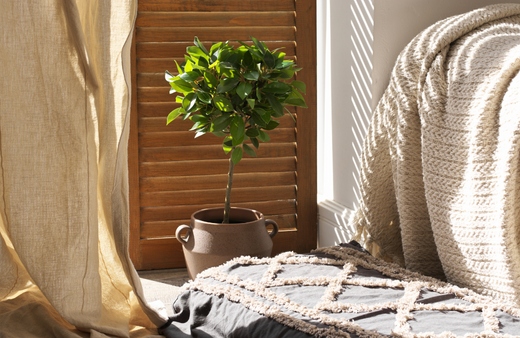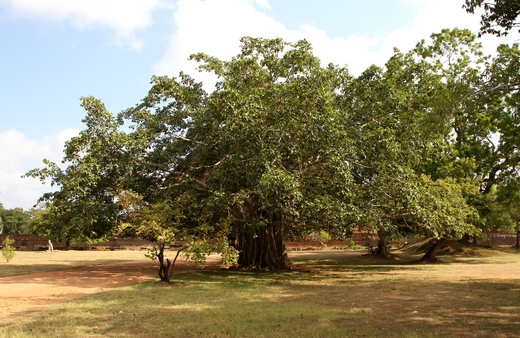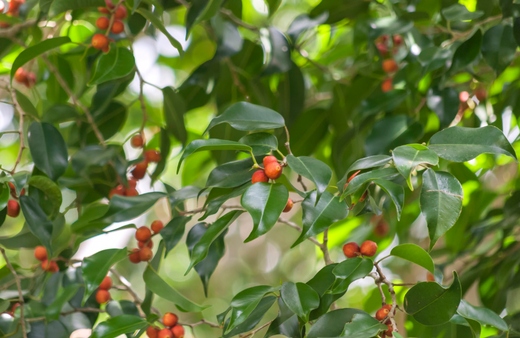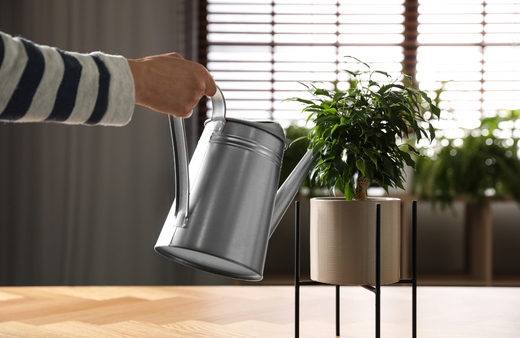Ficus benjamina is one of Australia’s pickiest plants, and it truly does hate being moved. But, if you can find the right spot to grow yours, indoors or out, you’ll have one of the most wonderful ficus trees to call your own, and might even get to benefit from its unusual fruit.
I’ve been obsessed with these native plants since I can remember, and they’re an utter joy to grow. If you want to learn how to grow them yourself, stick with us through this guide to growing Ficus benjamina at home in Australia.
More...

Family: | Moraceae |
|---|---|
Genus: | Ficus |
Species: | F. benjamina |
Common Names: | Weeping fig, Benjamin fig, Ficus tree |
Location: | Indoor or outdoor |
Type: | Tree |
Growth: | 30m outdoors, 2m indoors |
Sun requirements: | Bright but indirect light |
Foliage Colour: | Green or variegated |
Flower Colour: | White |
Flowering: | Late spring to early summer |
Fruit: | Hard orange fruit in late summer, early autumn |
Maintenance level: | Low |
Poisonous for pets: | Toxic to cats and dogs |
What is Ficus benjamina?

Ficus benjamina is a plant in the fig family, and it does, in fact, produce a sweet, but very hard fruit with a thick orange rind, but a flavour that is similar to more common soft figs and works well raw, baked, or dried.
Ficus benjamina, as its common name suggests, is a weeping fig, with dangling limbs and tons of drooping foliage on wiry stems. While they can be invasive (especially in humid tropical regions) they are generally easy to care for but do have a famous tendency to suddenly die when moved.
Weeping Fig’s Natural Habitat
Ficus benjamina is native to Australia and parts of Asia, and has naturalised through the West Indies and some southern parts of the United States. Essentially, anywhere warm and humid will provide a happy home for these ethereal waxy-leaved trees.
How to Grow Ficus benjamina
Weeping figs are really quite simple to grow, provided you have a bright, sunny position, with shelter from afternoon sun while they are young, and soil that is rich in organic matter, but not damp.
Strangely, occasional flooding can actually benefit the plant, but only for a few days per year, which seems to support sustained leaf health through summer.

Growing Ficus benjamina Outdoors
When Ficus benjamina is truly happy, it can actually be quite thuggish. Broken pots, roots that force down into concrete, and fruits that self-seed around the garden are common problems in gardens in tropical and subtropical Australia, so consider planting them somewhere that they won’t be 100% happy.
It sounds mean, but it will save you a lot of headaches, and still provide you with seasonal interest from the gorgeous weeping trees.
Soil
Ficus benjamina needs well-drained soil, ideally improved with lots of organic matter. Avoid regular waterlogging or over-watering, but do try to keep the roots fairly moist to avoid harsh tap roots digging deep to find water.
Position, Light & Temperature
Position your weeping fig in a bright location but with some dappled shade in the afternoon. As the tree matures outdoors it can reach heights of 30 m or more and will make a beautiful statement in any garden, but while young, they do benefit from some protection from extreme light and heat.
Fertiliser and Mulch
Ficus benjamina is really quite hungry, especially outdoors where they need nutrients to balance their fruiting habit in late summer. A generous mulch of any organic materials in spring is adequate as using annual feed for these trees.
And once they mature, mulch them heavily every three years, rather than lightly each year.
Pruning
Weeping figs don’t need much pruning and tend to develop a better shape without any pruning, but if there are signs of fungal problems, sun scorch, or branches that have developed discoloration, it's safer to cut them off back to a healthy section of wood.


Get Your Free Guide:
Master Growing Australian Natives eBook
A Must Have Complete Guide for Every Australian Garden
Get Your Free Guide:
Master Growing Australian Natives eBook
A Must Have Complete Guide for Every Australian Garden
If you do cut back your weeping fig, wear gloves or wash your hands immediately after as the sap is highly irritant and can cause a particularly itchy rash.

Caring for Ficus benjamina Indoors
Despite being native plants, their invasive habits often make them more attractive as house plants, which limits their spread and reduces the chance of flowering or fruiting severely.
While that might sound like a negative, these trees are largely grown for their drooping, rustling foliage, which works beautifully in a bright window, away from direct sun.
Pot Size
Plant Ficus benjamina in a pot about twice the size of the root ball. Its roots are quick to establish, and the moist soil around the roots will support new growth in its new location. Avoid compaction in any way, especially with indoor ficus, as this can rapidly defoliate plants.
Location
Finding the right location, and sticking to it is crucial to Ficus benjamina, which will defoliate, and can die in a matter of weeks when moved. Choose somewhere bright, but out of direct afternoon sun (ideally 4 hours of direct morning or evening light) with good ventilation and reasonable humidity.
Young plants are quite resilient to being moved, but do keep an eye on them when you first bring them home from the garden centre and try to adapt their setting if they show any signs of weakness for the first week.
Feeding
Mulch is rarely an option for indoor plants, and changing the soil too regularly will cause more problems than benefits, so use a good quality organic houseplant fertiliser to feed Ficus benjamina once a month through spring and summer.
How to Propagate Ficus benjamina
Weeping figs are best propagated from cuttings, but seed propagation and air layering are both possible too, though for the purposes of this article, we’ll leave air layering as it is both complicated and unreliable with any ficus.
Propagating Ficus benjamina from Seeds
To grow Ficus benjamina from seed, you will need some basic materials:
- Propagator tray, with lid (or plastic bag)
- Vermiculite
- Sieved compost or seed compost
- Patience
Method:
- Fill a clean propagator tray with moisture-retentive seed compost, or sieved compost.
- Sow seeds thinly across the surface.
- Cover with a very thin layer of vermiculite to reduce light and retain moisture at the surface.
- Water well.
- Leave somewhere warm and bright (25°C), misting every few days if the soil dries out.
- Germination can take up to 2 months.
- When seedlings are large enough to handle, transplant them into individual pots.
Propagating Weeping Fig from Cuttings
Taking Ficus benjamina cutting is actually pretty simple, and will work in water, soil, or damp perlite. All you need is a pair of gardening gloves, clean, sharp secateurs, and a container. Optional extras include rooting hormone, soil, or perlite.
- Take a 10-15cm cutting from a healthy stem, including leaves and side shoots if necessary.
- Remove about 2/3 of the leaves, and cut the base of the cutting at a 45 degree angle, just below or through a node.
- If you have it, dip the cut end in rooting hormone.
- Place the cutting into a small pot filled with compost and perlite, or a glass of clean water (soil cuttings root faster, but water cuttings are more reliable and less susceptible to infection)
- Store in a bright location with protection from direct midday sun, and keep the cutting moist and misted for the next few weeks.
- When roots have noticeably grown (4-5 inches in water, or out of the drainage holes in soil) plant the cutting into a larger container filled with any moisture-retentive compost.
Harvesting Ficus benjamina

Like all figs, the fruit of Ficus benjamina develops from the flower and is not, technically, a fruit at all. The flowers are lined on the inside of the fruit, which has a tiny opening for pollinators. When it's ready, the pollinated flowers turn into what we know as a fig.
In the case of Ficus benjamina, that fruit is orange, with a particularly hard outer skin, but the whole thing is edible and tastes just like its darker counterpart of the common fig tree.
When and How to Harvest Ficus benjamina Fruit
Once the fruits of Ficus benjamina have turned bright orange and the outer skin is tough to touch, you can gently twist them from the plant and either cook them, dehydrate them, or eat them raw (if your jaw is up to the task).
Weeping Fig Pests and Diseases
Outdoors, Ficus benjamina rarely suffer from any pests in Australia, but when they are grown indoors, or even briefly as cuttings indoors, they do suffer from common houseplant pests like aphids, mites, and mealybugs, which are simple to remove, either by scraping or with an organic neem oil spray.
In terms of diseases, there is a wide array of bacterial and fungal problems that affect ficus in general, and Ficus benjamina is no stranger to them. Perhaps the most common is branch dieback, caused by the phomopsis fungus, which affects roots, and prevents nutrients from reaching leaves, resulting in dropped foliage and browning, wilting branches that shrivel up.
Brown patches, orange lesions, or black spots on ficus leaves are common signs of fungal infection, and the most effective treatment is always to cut the affected leaves off when you see them.
If an entire tree is affected, treat the soil with a copper-based fungicide, and apply neem oil to the leaves in the late morning, checking that the infection dried out, rather than spreading further.
Ficus benjamina Frequently Asked Questions

How often should you water a Ficus benjamina?
You should only water indoor Ficus benjamina when the top surface of the soil is dry to the touch. Indoor ficus are less resilient to waterlogging than outdoor specimens, but if you can find the right temperature and lighting situation for them, you should (typically) water your ficus once a week.
Do Ficus benjamina like to be misted?
Ficus benjamina does appreciate misting if you don’t have a humidifier, as they are tropical plants and are used to high humidity in their native environment. Providing a weekly misting will help to regulate their water loss, and help to keep leaves dust free.
If you are interested in getting a humidifier, check out our plant humidifier buying guide for 2023.
What is the lifespan of Ficus benjamina?
Ficus benjamina will live outdoors in Australia for well over 200 years, with the oldest on record found in the Philippines being confirmed as at least 400 years old. While indoor plants tend to have shorter lifespans, it is more than possible to keep your Ficus benjamina going for decades.
What are the leaves falling off my ficus?
Just as Ficus benjamina doesn’t like being moved, it also doesn’t really enjoy seasonal changes. Rather than holding onto its leaves, which seems to be its instinct, it will lose its foliage entirely in winter, leaving a sad-looking bar set of stems, particularly on indoor plants. Don’t worry though, these usually recover in spring.
Can I keep a Ficus benjamina in the bathroom?
Ficus benjamina really does enjoy bright bathrooms, and can even be kept in open shower rooms, where the warm humidity massively benefits their overall health, and is much better for them than cool misting.
How do you control Ficus benjamina roots?
Ficus benjamina will send out damaging and brutish roots if it is not regularly watered. In pots and containers that are well fed and watered, Ficus benjamina will behave well.
However, if it is allowed to dry out or goes through prolonged droughts, it will respond by sending tough, surface-level roots out that can crack concrete.
How do I make my Ficus benjamina bushy?
The easiest way to encourage bushier growth on your Ficus benjamina is to prune to just above a node. Nodes are where the leaf leaves a stem, but they are also where new stems develop.
Cutting above a node will encourage new shoots, each with its own leaves, a process that can be repeated every year to create bushier and bushier plants.
Wrapping Up Our Ficus benjamina Guide
If you are at all put off by the thuggishness of Ficus benjamina roots, remember that these are native trees, so unless they are really struggling they do tend to behave themselves in our gardens. If you’re still concerned, consider growing your own in a pot, indoors, with more regular care and attention to watering and humidity.
Growing Ficus benjamina inside is an easier way to maintain a happy, healthy weeping fig, and provides a gorgeous canopy of fluttering foliage in any room.
Published on March 15, 2023 by Lorri Hopkins
Last Updated on January 25, 2025




